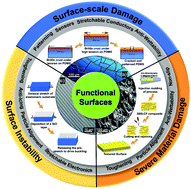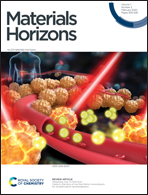Advanced functional surfaces through controlled damage and instabilities
Abstract
Functional surfaces are of paramount engineering importance with applications in non-wettable components, adhesion, anti-biofouling, static or dynamic optical properties, and energy scavenging. Traditionally, such functional surfaces have been produced through conventional methods of manufacturing like photolithography, hot embossing, and laser ablation which are generally very complex and costly. Likewise, it has been shown that using material damage or instabilities in an organized manner can lead to the generation of functional surfaces. The purpose of this review is to bring to attention these new fabrication pathways together by disclosing their importance as new practical manufacturing methods that would benefit researchers and engineers in various fields. In this review, three categories of mechanical damage and instabilities have been selected through which functional surfaces could be manufactured. The first category encompasses surface-scale damage mechanisms for creating functional surfaces. Although surface destructive mechanisms such as surface cracking are regarded as unwanted phenomena in surfaces, several studies have implemented them in micro-/nanoscale surface patterning, sensors, and superhydrophobic surfaces. The second category introduces techniques that use severe damage like cutting or breaking the bulk material to create new functional surfaces with applications in non-slip surfaces, hydrophobicity, and increased toughness. Instability-induced techniques are selected as the third category addressed in this review. Buckling in structures and surfaces is recognized as a blister anomaly; however, a number of studies demonstrate using buckling in a disciplined manner would lead to generating functional surfaces for applications including flexible electronics, surface patterning, wettability, and anti-icing surfaces. As discussed in this review, such inspiring and counter-intuitive methods of fabrication will shed light on the ability of common failure mechanisms to be employed as a sustainable design approach for generating new functional materials and surfaces with value-added properties.



 Please wait while we load your content...
Please wait while we load your content...